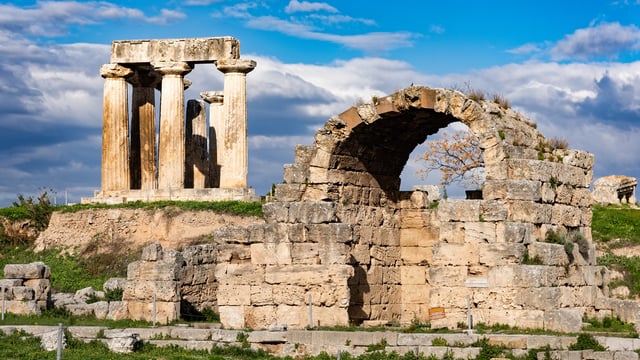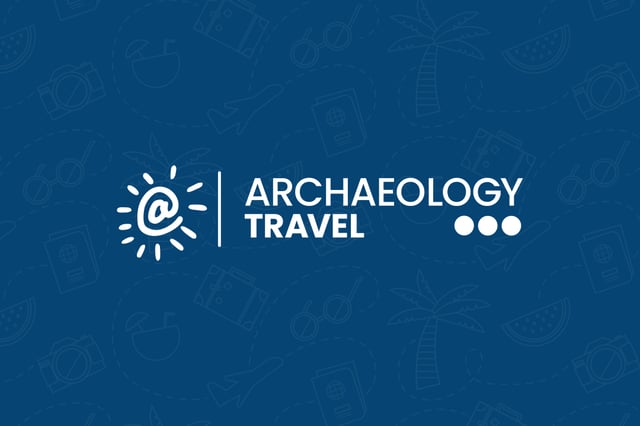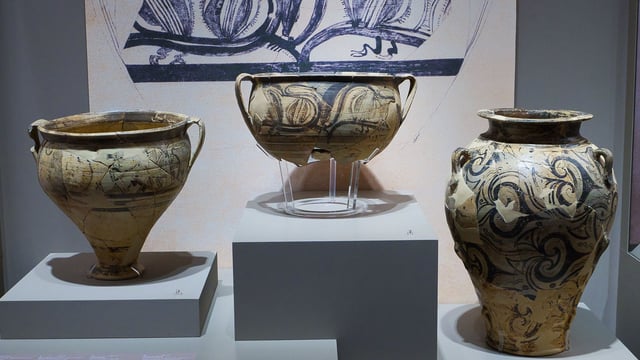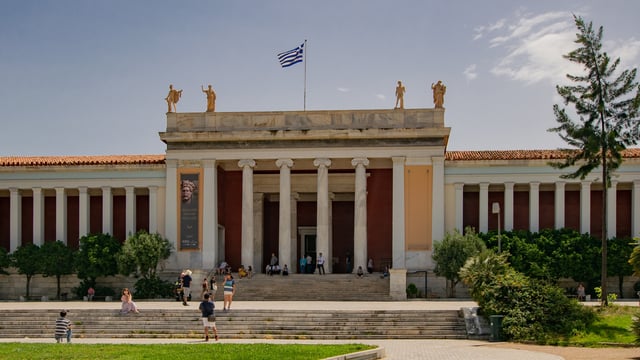Exploring Roman Greece
Different parts of what is now the nation state of Greece came under Roman rule at different times. The peninsular fell to the Romans during the Battle of Corinth in 146 BC. Whereas Crete was conquered by the Romans later, in 66 BC. The final conquering of the Greek world came following the Battle of Actium in 31 BC, when Augustus defeated Cleopatra VII, the Greek Ptolemaic queen of Egypt, and Mark Antony, and shortly afterwards captured Alexandria, the last great city of Hellenistic Egypt. Life under the Romans carried on much the same, in fact Roman culture was heavily influenced by the ancient Greeks.
Roman Sites & Ruins in Greece
Ancient Corinth
From the earliest times in antiquity to the medieval period, Corinth has been and important commercial centre. By the 4th century BC Corinth was one of the most important cities in ancient Greece. Although destroyed by the Romans in 146 BC, the city was rebuilt and became the provincial capital of Greece. Again it was destroyed, by earthquake in the 4th century AD. And again rebuilt, in the Byzantine period. Artefacts recovered from numerous excavations in the area are on display in the on site museum.

Aptera Archaeological Site
The archaeological site of Aptera has a spectacular Greek theatre with wonderful views, and a number of Roman ruins as well as the remains of a monastery. First mentioned in the late 12th century, the Monastery of St. John the Theologian was active until 1962. Overlooking the Bay of Souda meant the ancient town of Aptera was an important city from at least the 8th century BC. It prospered during the Roman period, but suffered a devastating earthquake in the 7th century AD, and subsequent raids by the Saracens.

Dion Archaeological Park
With an excellent view of Mount Olympus, the ancient town of Dion grew up around a sanctuary dedicated to Zeus – who is said to have lived on Olympus. For ancient Macedonians this was an important sacred place, and since the end of the 5th century BC it was a leading centre for the ‘Olympian Games of Dion’, to honour and worship Zeus and his daughters. An archaeological walk has been created allowing visitors to experience the significant elements of the site.

Gortyn
Although a flourishing city was mentioned by Homer, it was not until the Hellenistic era that the city of Gortyn was at its most prosperous and powerful. During the Roman period the city became the capital city of the province of Creta et Cyrenaica. Later, in the 6th century AD a Christian cathedral was erected and dedicated to St Titus, the ruins can still be seen today. The site is best known for the Gortyn Code, discovered in 1884 it is the most complete and oldest example of a code of ancient Greek law.

Hadrian's Arch
Unlike many other comparable Roman arches, the Arch of Hadrian appears to be a much more slight and slender construction. A single arch spanned a road that would have lead back to the Acropolis. Two inscriptions on the architrave seem to suggest that the arch marked the boundary between old and new Athens. When in 1778 the Turkish governor Hadzi Ali Haseki built a wall to enclose the lower city, Hadrian’s Arch was incorporated as a gate in this wall. Unlike other monuments which were destroyed in this process.

Hadrian's Library
Built in 132 CE, the Library was a gift from Emperor Hadrian to the people of Athens. Hadrian was a committed Hellenophile, and he did much to leave his mark here. Today we enter the site at the imposing Pentelic marble façade, with its monumental Corinthian gateway. A small onsite exhibition room houses a colossal statue of Nike and some other artefacts recovered on the site.


Isthmia
An ancient city known for its Temple of Poseidon and the Isthmian Games (one of the Panhellenic Games). Today visitors come to see the exceptionally well preserved and beautiful mosaic floors in the bath house, as well as the ruins of the Temple of Poseidon. Isthmia suffered the same fate as Corinth at the hands of the Romans in 146 BC. And it was not until 44 BC that Julius Caesar had the temple and stadium restored. The site was rediscovered and excavated in 1952 by the Swedish archaeologist Oscar Broneer.

Kerameikos Archaeological Site & Museum
A walkable distance from the main concentration of ancient sites north-west of the Acropolis is the oldest and largest ancient cemetery of Kerameikos. This was one of the largest districts of ancient Athens, and it was here that the potters who made the iconic ‘Attic vases’ lived and worked. Besides funerary features, you can also see part of the Themistoclean Wall, the Dipylon Gate and Sacred Gate. An onsite museum houses artefacts from the site, mostly dealing with funerary customs and rituals through the ages.


Nicopolis
The ‘city of victory’ was founded by Octavian (Augustus) in 31 BC following and to commemorate his victory against Mark Anthony and Cleopatra at the Battle of Actium. Establishing the town was an act of great political propaganda. It was an important Roman town, but decreased in size and significance in the Early Christian period. Scattered about a large area to the north of present-day Preveza are many features from different periods. Some are gated, and require an entry ticket, while others are freely accessible.

Nicopolis Aqueduct at Agios Georgios
The Nicopolis Aqueduct begins on the north west edge of Agios Georgios. Here a number of features have been found by archaeologists, some of which can be seen today. Water was collected in hillside springs and channelled into a collecting basin, which is now under the Church of St George. At one section the vaulted roof has survived. The canal then crossed the Louros River over a brick arcade. You will see two arcades: the southern, better preserved one having been built to replace the northern one.

Nicopolis Aqueduct at Archangelos
On the outskirts of Archangelos, at the northeast and south, it is possible to see the ruins of the aqueduct’s arcade. All that remains are the brick-built piers. The arches have not survived, although at the southern line of piers, some are preserved up to the spring of the arch. The piers continue south of the tarred road, and the line of the aqueduct can be followed, with scattered remnants of piers along a line of trees between cultivated fields, for some distance towards its final destination in Nicopolis.

Nicopolis Aqueduct at Kokkinopilos
On the east side of the Ioannina-Arta highway(E951) is a tunnel entrance that was made when the highway was constructed. This leads to that part of the Nicopolis aqueduct that runs east-west underground through tunnel cut through natural bedrock. The tunnel is about 400 m in length at a depth of 20 m. from the rock surface. It is not possible to enter the tunnel, but as you are driving passed it is worth stopping and having a look inside.

Nicopolis Aqueduct at Stefani
On the side of a hill above a stretch of road (21) running between Stefani and Louros the preserved sections of the Nicopolis aqueduct show some interesting features. The course of the construction is not high above the road, so easily accessible. The outer retaining wall of the feature is clearly visible from the road. Two different building techniques were used here, leading archaeologists to believe that there were two different phases of construction.

Olympia Archaeological Site
One of the most important archaeological sites of ancient Greece, Olympia is known as for the origins of the Olympic games. First held here in the 8th century BC, and again every four years until the 4th century AD. As the location of the largest sanctuary to Zeus, ancient Olympia was also an important religious and political centre. Monuments to successful athletes were placed alongside monuments to the gods and victorious battles. Many of these monuments have survived, and are in a relatively good state of preservation.

Olympieion - Temple of Olympian Zeus
Although the colossal Temple of Olympian Zeus can be seen from the street (it is one of the largest Classical temples), this is a monument that definitely should be experienced up close. When completed by Hadrian in the 2nd century CE 104 columns made up the temple. Of these, only 16 remain standing today. There are many other features on site, including a Roman bath house, a basilica and the remains of the city’s walls.


Museums in Greece with Roman Collections
Acropolis Museum
Opened in 2009, this award winning museum displays over 4,000 objects from the nearby Acropolis. These range from the Bronze Age to Roman and Byzantine periods on the citadel. One of the reasons for the construction of this state-of-the-art museum was the reunification of sculptures taken by Lord Elgin from the Parthenon. The museum was constructed above the archaeological site of Makrygianni. Visitors can follow walkways in a space under the museum to see in situ features of Roman and early Byzantine Athens.


Archaeological Museum of Dion - Archaiotheke of Dion
The Archaeological Museum of Dion was established to display artefacts recovered from the nearby site of Dion – a large fortified city occupied from the 6th century BC to the 5th century AD. Artefacts from other sites in the region, including those at the foot of Mount Olympus, are also on display here. The range of objects exhibited is vast, from exquisite marble statues and mortuary monuments to more mundane artefacts of daily life. Next to the museum is the Archaiotheke of Dion, which was built to house the Dionysus Mosaic.

Archaeological Museum of Heraklion
The archaeological museum in Heraklion is one of the largest and most important archaeology museums in Greece. Not only does the museum have extensive displays of some 7,000 years of Cretan prehistory, from the Neolithic to the Late Roman period, it also has the finest collection of Minoan art and artefacts. Some of the island’s most iconic objects can be seen in permanent exhibitions, these include the enigmatic Phaistos disk, the bull head rhyton from Zakros and bull leaping fresco from Knossos.

Archaeological Museum of Ioannina
With over 3,000 artefacts in 8 exhibition areas, the museum tells explores the history of Epirus from around 250,000 years ago to the 3rd century AD. From the earliest Stone Age inhabitants of the area to the late Roman period, with displays arranged regionally, chronologically and thematically. An entire gallery is devoted to the archaeology of the Sanctuary of Dodoni, where the history of Greece’s oldest is set out. After a 5-year refurbishment, the museum reopened in 2008 with modern and engaging displays.

Archaeological Museum of Kozani
Artefacts from the Palaeolithic to the Roman period from all over the prefecture of Kozani are on display in this early 20th century Neoclassical style museum. The objects range from everyday items to beautiful prehistoric and ancient jewellery, as well as an impressive collection of Roman marble statues. One display that stands is that of the metal objects recovered from Iron Age sites in the area, including a 3rd century BC necropolis.

Archaeological Museum of Pylos
Within the walls of Niokastro Fortress above the modern-day town of Pylos, and housed in the Maizonos Building is the recently opened archaeology museum. With the use of innovative displays and digital presentations, the museum exhibits artefacts from archaeological sites in and round Pylos, as well as the broader Messinia area. These displays begin with prehistoric periods and include all the periods until the recent past. Given the significance of archaeology sites in the area, this is one of Greece’s more important museums and is well worth a visit.

Archaeological Museum of Sparta
Opened in 1876, the Archaeological Museum of Sparta is the first provincial museum in Greece designed and built for this purpose. With additions since, the museum has seven galleries, with display ranging from the Neolithic to the later Roman period. Given its location, the museum exhibits numerous artefacts from the archaeological site of Sparta. A highlight of these exhibits are the well preserved mosaic floors from the Hellenistic and Roman periods of occupation at Sparta.

Archaeological Museum of Thessaloniki
Permanent exhibitions include some of the finest antiquities and artefacts of ancient Greece, from prehistory to late antiquity. One of many highlights includes the largest collection of gold wreaths from Macedonian cemeteries. The artefacts in these collections come from private donations and gifts, as well as archaeological sites excavated in Macedonia since 1912, when the museum was founded. The museum is in the centre of Thessaloniki, close to many other museums and popular attractions. Visitors with a range of accessibility requirements are well catered for.

Athanasakio Archaeological Museum of Volos
Built in 1909, the museum with its striking neoclassical façade is one of the oldest archaeology museums in the country. On display are artefacts recovered from 20th century excavation of sites in the Thessaly region. These range from the neolithic and Mycenaean periods, through to Roman and Byzantine periods. The highlights of the museum include the archaeology of the Neolithic settlement of Dimini, with reconstruction of domestic dwellings in the gardens.

Athens International Airport Museum
In the main terminal of the Athens International Airport there are three permanent exhibitions, free to visit. The first is an exhibition of the archaeology found during the construction of the airport in the Mesogaia area. On display are 172 archaeological artefacts from the Neolithic to the Post-Byzantine period. A small area with a few replicas and digital displays covers the Acropolis Museum. A third multimedia presentation explores Eleftherios Venizelos’ role in forming the modern Greek nation as well as its aviation ministry.

Delphi Archaeological Museum
The museum was founded in 1903 to mark the end of the first major programme of excavation at the archaeological site of Delphi. With the volume and size of objects recovered at the site, the museum has been expanded and redesigned many times since. In 14 galleries covering 2000 square metres of floor space are displayed some of the best artefacts, sculptures and architectural elements, including the Charioteer of Delphi, the frieze of the Siphnian Treasury, the cult statue of Antinous and the Sphinx of Naxos.

Focas Cosmetatos Foundation
Once the Focas Cosmetatos family home, the building was severely damaged during an earthquake that struck Kefalonia in 1953, and the fires that raged in the aftermath of the quake. Almost unrecognisable, the house was rebuilt and turned into a museum and art gallery, showcasing the family’s collection of art, furniture and other historical objects relating to the history and culture of Kefalonia and other Ionian Islands. These include a collection of historic lithographs and coins and bank notes, with items from ancient Greek, Roman and Byzantine periods.

Museum of Cycladic Art
Established in 1986, the Museum of Cycladic Art houses Nicholas and Dolly Goulandris’ extensive collection of Cycladic and Ancient Greek art. The couple had been collecting prehistoric and ancient art since the 1960s. The museum also has one of the largest collections of Cypriot antiquities in the world outside of Cyprus. There are three permanent exhibitions: Cycladic art from the Cycladic Islands (3200 – 2000 BC), Greek art (2000 BC to 395 AD), and art from Cyprus (3900 BC to the 6th century BC).


Museum of Paul and Alexandra Kanellopoulos
On the north slopes of the Acropolis is the Neoclassical Michaleas residence, built in 1894 and now home to one of the richest private collections of ancient artefacts. There are over 7,000 objects, ranging in date from the Neolithic period to the Post Byzantine era. The objects are displayed in chronological and thematic order. This was the private collection of Paul and Alexandra Canellopoulos that they donated to the Greek state in 1972 and opened to the public in 1976. In 2004 an extension was built so that the entire collection could be exhibited.

National Archaeological Museum of Athens
Greece’s National Archaeological Museum in Athens is home to some of the most well known artefacts from all over the modern nation state of Greece. From prehistory to the Romans, with special collections of Cypriot and Egyptian antiquities. The museum has been in the current building with its spectacular Neoclassical façade since the 1889, but has been expanded many times since then. With the richest collection of ancient Greek artefacts anywhere in the world, this is a must for anyone with an interest in ancient Greece.


































